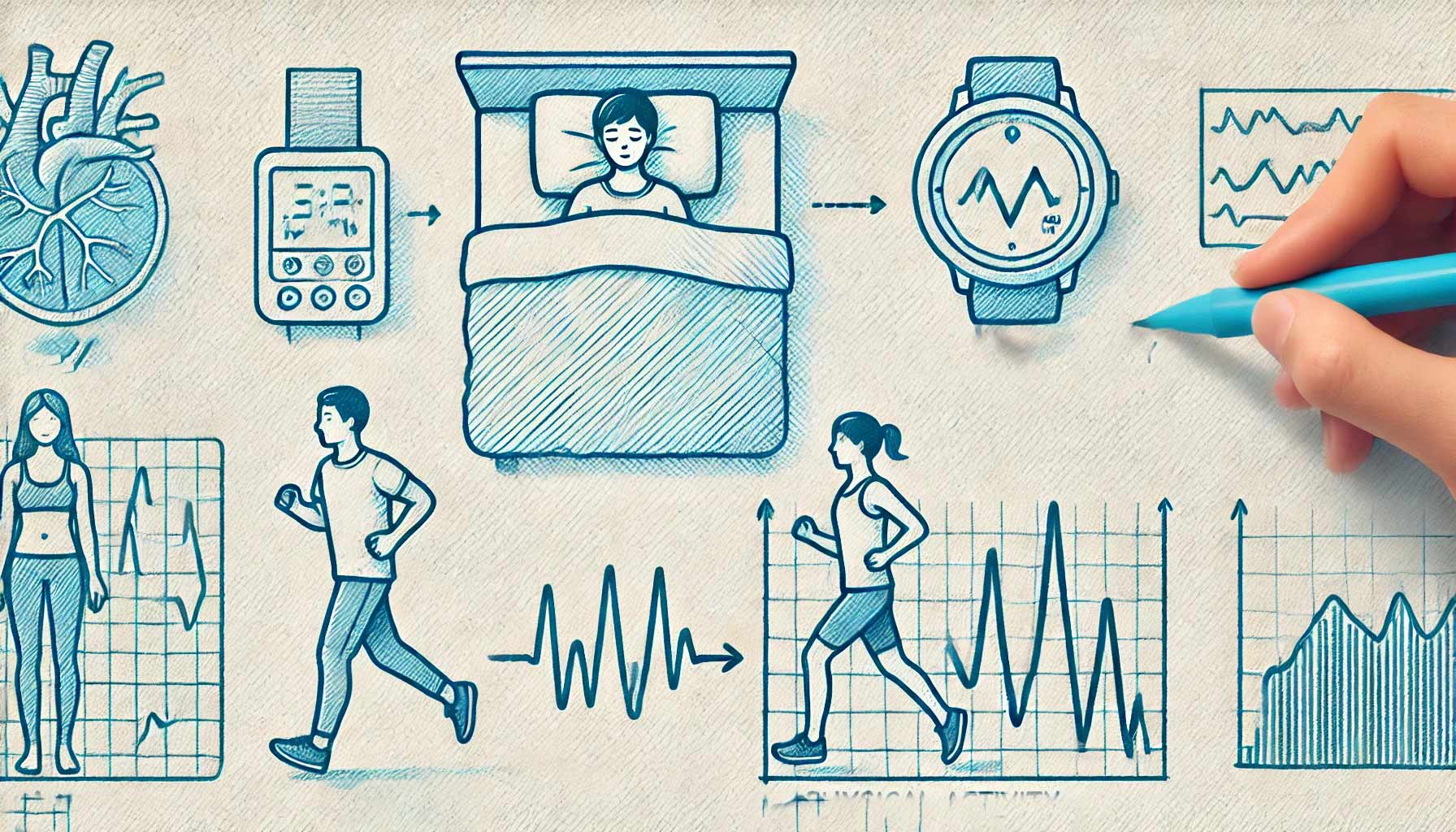Leveraging Wearable Technology for Comprehensive PTSD Management
Post-Traumatic Stress Disorder (PTSD) impacts multiple areas of a person’s health, including their sleep patterns, physical activity levels, and autonomic nervous system (ANS) regulation. Addressing these components holistically can greatly improve the management of PTSD. Wearable devices that track sleep, physical activity, and HRV (heart rate variability) provide an opportunity to gather real-time, comprehensive data that can support more effective treatments. By combining these metrics, clinicians can gain a better understanding of how PTSD affects both mind and body and tailor interventions accordingly.
This article explores how sleep tracking, activity monitoring, and HRV biofeedback can be used together for more integrated and effective PTSD management.
1. The Importance of Holistic Monitoring in PTSD Management
PTSD doesn’t only affect the mind; it also has significant physical implications. Individuals with PTSD often suffer from disrupted sleep patterns, reduced physical activity, and heightened ANS dysregulation. These factors exacerbate the mental health challenges faced by PTSD sufferers and can delay recovery. For a deeper look at how HRV tracking supports mental health, consider “HRV and Nutrition: Exploring the Heart-Gut Connection”.
PTSD and its negative impact on well-being:
- Sleep disturbances such as insomnia, nightmares, and fragmented sleep are some of the most common and distressing symptoms. Poor sleep, in turn, heightens anxiety and worsens PTSD symptoms.
- Sedentary behavior often increases with PTSD. Lack of regular movement can contribute to both poor physical health and worsening mental health, trapping individuals in a cycle of inactivity and emotional distress.
- ANS dysregulation: Individuals with PTSD tend to have lower HRV, meaning their bodies struggle to effectively regulate stress responses. This leads to heightened sympathetic activity (fight-or-flight) and insufficient parasympathetic regulation (rest-and-digest).
Combining monitoring of sleep, physical activity, and HRV allows for a more comprehensive understanding of how PTSD affects overall health. Each of these metrics provides valuable information that can help guide treatment decisions and track progress over time.
2. HRV Biofeedback: A Core Component of PTSD Management
HRV biofeedback is a technique used to help individuals improve their heart rate variability, which is an indicator of how well the body is balancing its sympathetic and parasympathetic systems. Lower HRV is often linked to poor stress regulation and is common in individuals with PTSD. For more on HRV biofeedback for improving stress responses, check out “Fibion Flash: The Best HRV and Activity Monitoring Device for Long-Term Data Collection”.
Through HRV biofeedback, patients learn to:
- Regulate their breathing to control their heart rate and improve vagal tone (a key measure of parasympathetic activity).
- Increase emotional control, reducing the intensity of stress and anxiety.
- Enhance overall ANS balance, helping to calm the body and mind during moments of hyperarousal or stress.
By tracking HRV in real-time through wearable devices, patients are empowered to make immediate adjustments in how they manage stress. Over time, these adjustments can lead to lasting improvements in emotional regulation and resilience.
3. Sleep Tracking for Better PTSD Management
Sleep disturbances are one of the most pervasive symptoms of PTSD. Individuals with PTSD frequently experience issues such as:
- Insomnia (difficulty falling or staying asleep).
- Nightmares and night terrors.
- Fragmented sleep that results in poor-quality rest.
Wearables that monitor sleep help clinicians and patients gain insights into:
- Sleep duration: How many hours of sleep are achieved each night.
- Sleep quality: How much time is spent in deep sleep and REM sleep, both critical for emotional and physical recovery.
- Sleep patterns: Identifying frequent awakenings or periods of restlessness that may be linked to PTSD symptoms.
Having access to this data allows for more tailored interventions aimed at improving sleep. For example, sleep hygiene strategies, relaxation exercises, or Cognitive Behavioral Therapy for Insomnia (CBT-I) can be introduced based on the specific issues revealed through tracking. For insights into using sleep monitoring to assess mental health, you may enjoy “How to Analyze HRV in a Research Project: A Guide for Researchers”.
4. Physical Activity Tracking for PTSD
Regular physical activity plays a crucial role in improving mental health, particularly for individuals with PTSD. Physical movement helps regulate the ANS, enhances emotional resilience, and promotes better sleep quality. However, individuals with PTSD often experience reduced activity levels due to symptoms like fatigue or anxiety.
Tracking physical activity with wearables provides several benefits:
- Monitoring daily activity: Wearables track steps, movement intensity, and active minutes, helping patients ensure they are getting enough physical activity.
- Encouraging regular movement: Many devices include reminders or goals to promote regular movement, helping break up long periods of sedentary behavior.
- Supporting structured exercise plans: With activity data, clinicians can recommend appropriate levels and types of exercise that are manageable and beneficial for the individual.
Physical activity, especially moderate-intensity exercises like walking or yoga, has been shown to reduce anxiety and improve overall emotional regulation in people with PTSD. Combining this with sleep and HRV data gives a fuller picture of how activity impacts overall well-being.
Conclusion
The Synergy Between Sleep, Activity, and HRV in PTSD Management
Combining sleep monitoring, physical activity tracking, and HRV biofeedback provides a more holistic approach to managing PTSD. These three areas are deeply interconnected, with each affecting the other. Better sleep supports emotional regulation, physical activity reduces anxiety and hyperarousal, and HRV biofeedback enhances stress management. To understand how combining multiple physiological metrics enhances PTSD management, consider “The Best Alternatives to BIOPAC’s AcqKnowledge Software for HRV Analysis”.
Utilizing Wearables for Real-Time Insights and Tailored Treatment
By using one wearable device to monitor all three metrics, individuals with PTSD and their clinicians can gain deeper insights into the physiological aspects of their condition, track progress more effectively, and adjust treatment plans in real-time. This integrated approach offers a powerful tool for improving overall mental and physical health, supporting long-term recovery, and enhancing quality of life.
Call to Action
📅 If you want to learn more about Fibion’s solution for measuring HRV, do not hesitate to book a video call with our expert Dr. Miriam Cabrita.

🔍 You may also discover our product portfolio on our website: Fibion Research, Fibion Vitals, Fibion Sleep, Fibion SENS, Fibion Emfit and Fibion Circadian, each with its unique set of features and applicability.
Frequently asked questions about this topic:
How does HRV biofeedback help in managing PTSD? +
HRV biofeedback helps PTSD patients regulate their stress response by improving heart rate variability and promoting better control over the autonomic nervous system.
Why is sleep tracking important for PTSD management? +
Sleep tracking helps identify sleep disruptions, such as insomnia or nightmares, which are common in PTSD. Monitoring sleep data allows for personalized interventions to improve rest and recovery.
How does physical activity tracking benefit PTSD patients? +
Physical activity tracking encourages regular movement, which can reduce anxiety and improve emotional regulation. It also helps patients reach daily exercise goals, supporting overall mental health.
Can wearables track HRV, sleep, and physical activity for PTSD management? +
Yes, many wearable devices can track heart rate variability, sleep patterns, and physical activity. Combining these metrics provides a more complete view of a patient’s health and helps tailor PTSD treatments.
How do sleep, activity, and HRV tracking work together to improve PTSD symptoms? +
These metrics are interconnected: better sleep improves emotional regulation, physical activity reduces anxiety, and HRV biofeedback enhances stress management. Together, they provide a holistic approach to PTSD care.
What are the benefits of using wearables for PTSD management? +
Wearables provide real-time data on HRV, sleep, and physical activity, allowing patients and clinicians to track progress and make timely adjustments to treatment plans for better PTSD management.
















